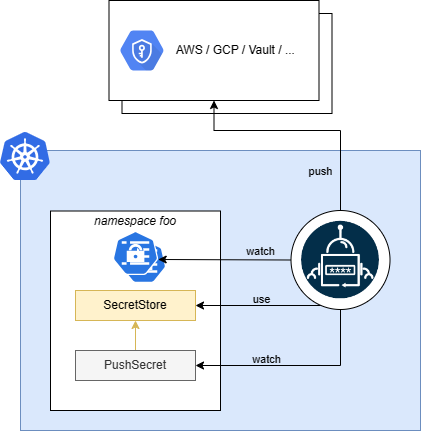PushSecret

The PushSecret is namespaced and it describes what data should be pushed to the secret provider.
- tells the operator what secrets should be pushed by using
spec.selector. - you can specify what secret keys should be pushed by using
spec.data. - you can also template the resulting property values using templating.
Example
Below is an example of the PushSecret in use.
---
# The source secret that will be pushed to the destination secret by PushSecret.
apiVersion: v1
kind: Secret
metadata:
name: source-secret
stringData:
best-pokemon-src: "Pikachu"
---
apiVersion: external-secrets.io/v1alpha1
kind: PushSecret
metadata:
name: pushsecret-example # Customisable
namespace: default # Same of the SecretStores
spec:
updatePolicy: Replace # Policy to overwrite existing secrets in the provider on sync
deletionPolicy: Delete # the provider' secret will be deleted if the PushSecret is deleted
refreshInterval: 1h # Refresh interval for which push secret will reconcile
secretStoreRefs: # A list of secret stores to push secrets to
- name: aws-parameterstore
kind: SecretStore
selector:
secret:
name: pokedex-credentials # Source Kubernetes secret to be pushed
# Alternatively, you can point to a generator that produces values to be pushed
generatorRef:
apiVersion: generators.external-secrets.io/v1alpha1
kind: ECRAuthorizationToken
name: prod-registry-credentials
template:
metadata:
annotations: { }
labels: { }
data:
# If the key source secret key has dashes, then it cannot be accessed directly,
# and the "index" function should be used.
best-pokemon: "{{ index . \"best-pokemon-src\" | toString | upper }} is the really best!"
# Also, it's possible to use an existing template from configmap where Secret is fetched,
# merged and templated within the referenced configMap data.
# It does not update the configmap, it creates a secret with: data["config.yml"] = ...result...
templateFrom:
- configMap:
name: application-config-tmpl
items:
- key: config.yml
data:
- conversionStrategy: None # Also supports the ReverseUnicode strategy
match:
# The secretKey is used within PushSecret (it should match key under spec.template.data)
secretKey: best-pokemon
remoteRef:
remoteKey: destination-secret # The destination secret object name (where the secret is going to be pushed)
property: best-pokemon-dst # The key within the destination secret object.
The result of the created Secret object will look like:
# The destination secret that will be templated and pushed by PushSecret.
apiVersion: v1
kind: Secret
metadata:
name: destination-secret
stringData:
best-pokemon-dst: "PIKACHU is the really best!"
Template
When the controller reconciles the PushSecret it will use the spec.template as a blueprint to construct a new property.
You can use golang templates to define the blueprint and use template functions to transform the defined properties.
You can also pull in ConfigMaps that contain golang-template data using templateFrom.
See advanced templating for details.
